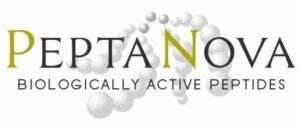Prolactin-Releasing Peptide (Human)
PrRP31 (Human) – Preprolactin (23-53) (Human)
4352-v 0.5 mg | 180.00 EUR
Ser – Arg – Thr – His – Arg – His – Ser – Met – Glu – Ile – Arg – Thr – Pro – Asp – Ile – Asn – Pro – Ala – Trp – Tyr – Ala – Ser – Arg – Gly – Ile – Arg – Pro – Val – Gly – Arg – Phe – NH2
| (M.W. 3664.1) | C160H252N56O42S |
Synthetic Product
The purity is guaranteed to be higher than 99% by HPLC
Specific Prolactin-Releasing Peptide (Human)
Novel peptide PrRP31 (Human) found using an orphan receptor expressed in the human pituitary
The G-protein coupled receptors have seven-transmembrane-domain (7TM), and call 7TM receptors. The 7TM receptor gene family comprises many receptors that control various physiological functions. Recently, many cDNA of 7TM receptors have been reported with known ligand. However, some 7TM receptor has unknown endogenous ligand and called orphan receptor. In these orphan 7TM receptors, only few peptide ligands have been identified. Such peptides are nociceptin [Nature, 377, 532 (1995)] / orphanin FQ [Science, 270, 792 (1995)] and orexin [Cell, 92, 573 (1998)] .
Prolactin-releasing peptide (PrRP), a new ligand for the orphan receptor hGR3 in the pituitary, has been identified by using the arachidonic acid metabolite releasing assay [Nature, 393, 272 (1998)].
Two peptides, the 31 amino acid residue peptide PrRP31 | Preprolactin (23-53) and its amino terminally truncated form (PrRP20) were isolated from bovine hypothalamic extract. Using the bovine PrRP31 sequence, precursors of bovine, rat and human PrRP were cloned. The rat and human peptides were identified from the corresponding cDNA sequences as the homologous 31 amino acid residue peptide with the amidated carboxyl-terminus as in the bovine peptide. Dissociation constant of Prolactin-releasing peptide (PrRP31) for hGR3 receptor is on the order of 10 pM. PrRP31 selectively stimulates the release of prolactin in a dose-dependent manner (10 pM-100 nM), which was verified by carrying out assay using primary cultured rat anterior pituitary cells.
Prolactin releasing activity has been reported for other peptides, including TRH, VIP, PACAP, oxytocin, vasopressin and others. However, these peptides are also known to exhibit the extra releasing activity of other pituitary hormones. Prolactin-releasing peptide can not mimic release of other pituitary hormones. In this sense, PrRP is the real prolactin-releasing peptide and will be useful in clarifying the specific functions of prolactin in the body.
References:
- S. Hinuma, Y. Habata, R. Fujii, Y. Kawamata, M. Hosoya, S. Fukusumi, C. Kitada, Y. Masuo, T. Asano, H. Matsumoto, M. Sekiguchi, T. Kurokawa, O. Nishimura, H. Onda and M. Fujino, Nature, 393, 272 (1998) (Original)
- F. Satoh, D.M. Smith, J.V. Gardiner, M. Mahmoodi. K.G. Murphey, M.A. Ghatei and S.R. Bloom, Br. J. Pharmacol., 129, 1787 (2000)(Pharmacol.)
This peptide (4352-v | PrRP31) is manufactured and distributed through Peptide Institute, Inc. under the license of Takeda Pharmaceutical Company , Ltd.


